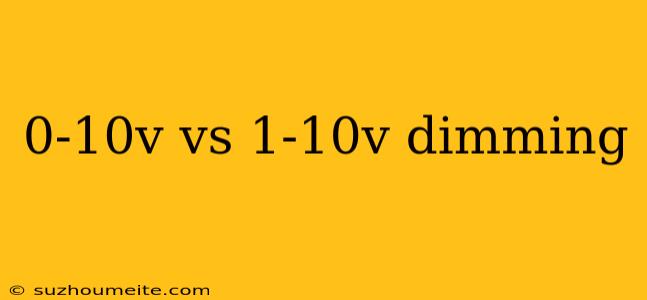0-10V vs 1-10V Dimming: Understanding the Difference
When it comes to lighting control, dimming is an essential aspect to consider. Dimming allows you to adjust the brightness of lights to create a desired ambiance, conserve energy, and even enhance the lifespan of light sources. There are several dimming protocols available, but two of the most common ones are 0-10V and 1-10V dimming. In this article, we will delve into the details of these two protocols, highlighting their differences, advantages, and applications.
What is 0-10V Dimming?
0-10V dimming is a popular protocol used to control LED drivers, fluorescent ballasts, and other lighting systems. This protocol involves sending a low-voltage signal (typically 0-10 volts) from a controller or dimmer to the lighting device. The voltage level determines the brightness of the light, with 0V representing complete darkness and 10V representing maximum brightness.
The 0-10V signal is usually sent through a dedicated control wire, which is connected to the lighting device. This protocol is widely used in commercial and residential buildings, including offices, hotels, and homes.
What is 1-10V Dimming?
1-10V dimming is similar to 0-10V dimming, but with a slight difference. In this protocol, the voltage signal ranges from 1V to 10V, instead of 0V to 10V. This means that the lighting device is always on, even when the voltage is at its lowest level (1V). The brightness of the light is still adjusted according to the voltage level, but the minimum brightness is not zero.
Key Differences Between 0-10V and 1-10V Dimming
Minimum Brightness
The most significant difference between 0-10V and 1-10V dimming is the minimum brightness level. In 0-10V dimming, the light can be completely turned off (0V), whereas in 1-10V dimming, the light is always on, even at its lowest level (1V).
Compatibility
0-10V dimming is more widely supported by lighting devices, making it a more versatile option. 1-10V dimming, on the other hand, is less common and may not be compatible with all devices.
Applications
0-10V dimming is often used in applications where complete darkness is required, such as in theaters, auditoriums, or home cinemas. 1-10V dimming is more suitable for applications where a minimum level of brightness is required, such as in stairwells, corridors, or public areas.
Advantages and Disadvantages
Advantages of 0-10V Dimming
- Complete darkness possible
- Widely supported by lighting devices
- Suitable for applications where complete control is necessary
Disadvantages of 0-10V Dimming
- May not be suitable for applications where a minimum level of brightness is required
- Can be more complex to install and commission
Advantages of 1-10V Dimming
- Always-on functionality
- Suitable for applications where a minimum level of brightness is required
- Can be simpler to install and commission
Disadvantages of 1-10V Dimming
- Limited compatibility with lighting devices
- Minimum brightness level may not be adjustable
Conclusion
In conclusion, 0-10V and 1-10V dimming are two popular protocols used in lighting control systems. While they share many similarities, the key difference lies in their minimum brightness levels. 0-10V dimming offers complete darkness, making it suitable for applications where complete control is necessary. 1-10V dimming, on the other hand, provides a minimum level of brightness, making it suitable for applications where a constant level of illumination is required. By understanding the differences between these two protocols, you can choose the right solution for your specific lighting control needs.
